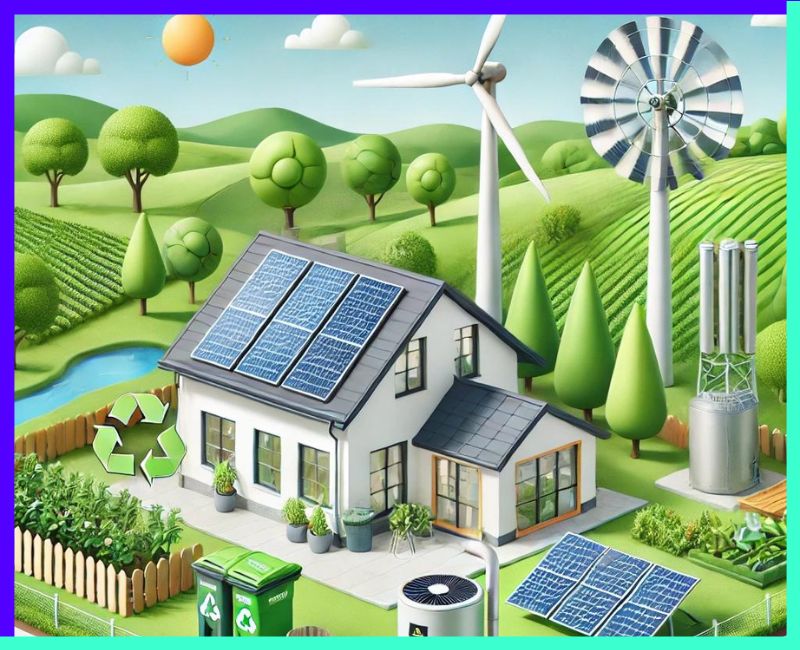As the world increasingly moves towards sustainability, finding green energy solutions to power your home is more important than ever. Green energy, also known as renewable energy, offers a sustainable way to meet your energy needs while minimizing environmental impact. In this article, we’ll explore the definition of green energy, the different types available, and practical examples of how you can implement these solutions in your home.
What is Green Energy?
Green energy refers to energy produced from natural sources that are abundant and sustainable, such as sunlight, wind, water, and geothermal heat. Unlike fossil fuels, which are finite and contribute to environmental degradation through pollution and greenhouse gas emissions, green energy is renewable and has a minimal environmental impact. By harnessing these natural resources, we can generate electricity, heat, and other forms of energy without depleting the earth’s resources or harming the environment.
The Importance of Green Energy
Adopting green energy solutions is crucial for several reasons:
- Environmental Protection: Green energy significantly reduces carbon emissions, helping to combat climate change and reduce air and water pollution.
- Sustainability: Unlike fossil fuels, renewable energy sources are inexhaustible and can be replenished naturally.
- Energy Independence: By generating energy locally from renewable sources, you reduce dependence on imported fuels and enhance energy security.
- Economic Benefits: Investing in green energy can create jobs, reduce energy costs in the long term, and drive technological innovation.
Types of Green Energy Solutions
There are several types of green energy solutions available for homeowners. Each type harnesses a different natural resource, offering unique benefits depending on your location and energy needs.
1. Solar Energy
Definition: Solar energy is derived from the sun’s radiation. It is one of the most widely used forms of green energy for homes, as it can be harnessed almost anywhere.
How It Works: Solar panels, typically installed on rooftops, capture sunlight and convert it into electricity using photovoltaic (PV) cells. This electricity can then be used to power your home, with any excess energy stored in batteries or fed back into the grid.
Examples:
- Solar Panels: These are the most common solar energy systems, used to generate electricity for homes and businesses.
- Solar Water Heaters: These systems use solar energy to heat water, reducing the need for conventional water heaters.
- Solar-Powered Appliances: Devices such as solar ovens and solar chargers can be used to directly harness sunlight for specific purposes.
Benefits:
- Reduces electricity bills
- Low maintenance costs
- Long-term investment with government incentives available
2. Wind Energy
Definition: Wind energy is generated by harnessing the power of wind through turbines. This type of energy is particularly effective in areas with consistent and strong wind patterns.
How It Works: Wind turbines capture kinetic energy from the wind and convert it into electricity. While large-scale wind farms are common, small wind turbines can be installed at homes in rural or open areas.
Examples:
- Residential Wind Turbines: Small turbines that can be installed on properties to generate electricity.
- Hybrid Systems: Combining wind turbines with solar panels for more reliable energy production.
Benefits:
- Ideal for rural or off-grid locations
- Can complement other renewable energy sources
- Reduces dependence on fossil fuels
3. Hydropower
Definition: Hydropower, or hydroelectric power, uses the energy of flowing water to generate electricity. It is one of the oldest and most reliable forms of renewable energy.
How It Works: Water flowing from a higher to a lower elevation is used to turn turbines, which generate electricity. While large dams are common, micro-hydropower systems can be installed on small streams or rivers.
Examples:
- Micro-Hydro Systems: Small-scale systems that can provide power to a home or small community.
- Pumped Storage Hydropower: A type of hydropower that stores energy for use during peak demand times.
Benefits:
- Reliable and consistent power generation
- Can be used in conjunction with other renewable sources
- Long lifespan with low operational costs
4. Geothermal Energy
Definition: Geothermal energy is derived from the heat stored beneath the earth’s surface. This energy can be used for both heating and electricity generation.
How It Works: Geothermal systems tap into the earth’s natural heat through wells or heat pumps. This heat is then used to warm homes or generate electricity, particularly in regions with geothermal activity.
Examples:
- Geothermal Heat Pumps: These systems use the stable temperature of the ground to heat and cool homes.
- Geothermal Power Plants: Large-scale plants that generate electricity from the earth’s heat.
Benefits:
- Provides consistent, year-round energy
- Low operating costs after installation
- Environmentally friendly with minimal emissions
5. Biomass Energy
Definition: Biomass energy is produced from organic materials such as wood, agricultural residues, and waste. This energy can be used for heating, electricity, and even fuel.
How It Works: Biomass is burned or converted into biofuels, which can then be used to produce heat or electricity. Biomass systems can be integrated into existing heating systems or used in standalone boilers and stoves.
Examples:
- Wood Pellet Stoves: These stoves burn compressed wood pellets to provide heating.
- Biogas Systems: Organic waste is processed to produce biogas, which can be used for cooking or electricity generation.
Benefits:
- Utilizes waste materials, reducing landfill usage
- Carbon-neutral when sustainably sourced
- Versatile and can be used in various applications
Read more – Renewable Energy Sources: Paving the Way for a Greener Tomorrow
How to Implement Green Energy Solutions at Home
Adopting green energy solutions for your home can be a transformative experience, leading to reduced energy costs, a smaller carbon footprint, and a more sustainable lifestyle. Here’s how you can start:
1. Assess Your Energy Needs
Before choosing a green energy solution, assess your current energy consumption. Identify areas where you can reduce usage, such as through energy-efficient appliances or better insulation.
2. Consider Your Location
The best green energy solution depends on your geographical location. For example, solar panels are ideal for sunny regions, while wind turbines may be more effective in areas with strong winds.
3. Start Small
If you’re new to green energy, start with small, manageable projects. Installing solar panels or a solar water heater is a great first step. As you become more comfortable, you can explore additional options like wind turbines or geothermal systems.
4. Explore Incentives and Rebates
Many governments offer incentives, tax credits, and rebates for installing renewable energy systems. Research what’s available in your area to reduce the initial cost of adoption.
5. Consult a Professional
For larger installations like wind turbines or geothermal systems, it’s essential to consult with a professional to ensure proper installation and compliance with local regulations.
Embrace Green Energy for a Sustainable Future
Adopting green energy solutions is a powerful way to reduce your environmental impact, lower your energy costs, and contribute to a sustainable future. By understanding the different types of renewable energy available and how they can be implemented in your home, you can take meaningful steps toward living a more eco-friendly lifestyle. Start small, explore your options, and enjoy the long-term benefits of powering your home sustainably.






